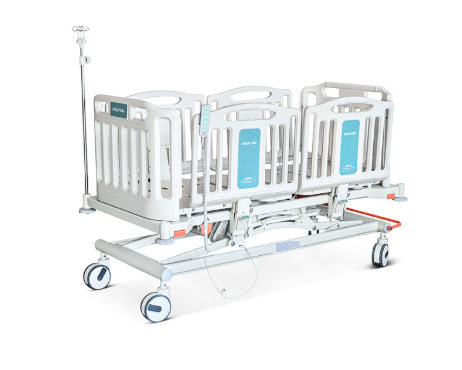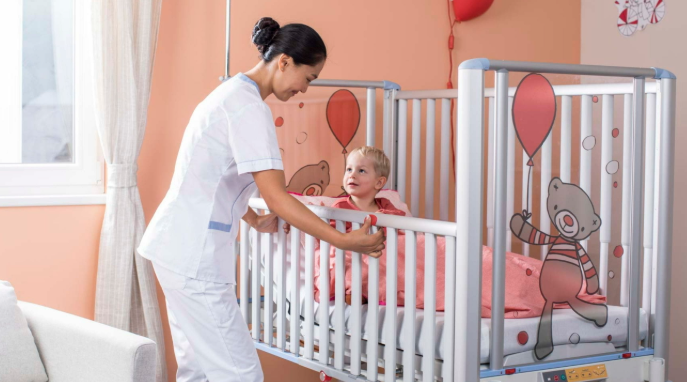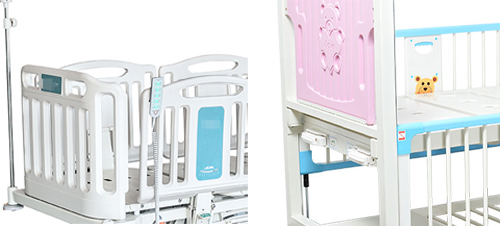Overview of Hospital Infant Bed Design Trends for 2025 in the USA
Based on my experience, I see some big changes coming for hospital infant beds in the USA for 2025. These designs are changing to meet what modern hospitals really need.
From what I’ve seen, all these trends mean future infant beds will be:
– Very flexible, making work easier for staff and welcoming for families.
– Full of new technology to improve how we monitor babies and keep them safe.
– Made to create a clean, caring space for the babies and their parents.

Key Design Features and New Technology
In my experience, hospital infant beds in 2025 across the USA are changing. They are starting to include smart technologies. I believe this makes them much safer and more comfortable for newborns and their families.
Advanced Smart Bed Systems
Wireless Monitoring & Smart Integration
I think the new smart systems are excellent. Modern infant beds have wireless systems that track vital signs 24/7. These controls help clinicians and parents use the bed easily. They can also check a baby’s status from another room.
Built-in Features for Clinical Use
I’ve seen how built-in weight scales and memory positions help. These features let hospital staff provide care more easily and safely. Some high-end models offer fast conversion options. This lets the bed switch between infant, child, or emergency modes in seconds. This added flexibility is a huge help, in my opinion, for busy delivery units.
Better Infection Control and Hygiene
Germ-Resistant and Smooth Surfaces
I suggest looking for new infant beds with special surfaces that stop germs from growing. These smooth, easy-to-clean materials let staff disinfect beds very fast between uses.
Ergonomics and Patient Comfort
Comfortable Materials and Adjustments
I like that memory foam mattresses and adjustable firmness levels make infants more comfortable. Many beds now have smart designs. Some even have built-in massagers and programmable comfort settings.
Adjustability for Recovery
Electronic adjustment features allow for care that fits specific needs. I feel this helps both babies and mothers recover better after birth.
Flexibility and Adaptability in Care
Modular Design and Quick Conversion
I find that flexible, modular bed designs make it simple to change a hospital room layout. This makes moving a patient from regular to ICU care very smooth. Features like adjustable bed sides and standard-sized outlets support different care needs. This means a hospital can adapt without major remodeling.
Child-Friendly and Healing Environments
Soothing and Natural Elements
Beds and rooms now use natural materials, soft colors, and curved shapes to make the space feel calm and healing. I’ve also seen features like themed art and access to natural light. These additions promote emotional comfort for children and families. I have read studies that show these designs improve recovery times and patient satisfaction.

Mobility and Ease of Use
Electronic Adjustments & Better Movement
I recommend hospital infant beds that have electronic height adjustment. They also have many position settings, including Trendelenburg and reverse Trendelenburg. The smooth mobility features and safe conversion options allow for fast changes during emergencies. This supports both caregivers and infants.
My Take on Practical Bed Designs
From my perspective, hospital infant beds in 2025 are all about creating a safer and more comforting space. I believe smart features and flexible designs are key to improving the environment for babies, parents, and medical staff.
Adjustable and Modular Designs
Electric and Manual Adjustments: I’ve noticed pediatric hospital infant beds now come with both electric and manual controls. This helps caregivers set the right height and angle for medical tasks. It also makes the baby and parents more comfortable.

Modular Parts: Many new beds have parts you can swap out. I think this is a great feature. It allows a bed to change into a procedure table, which makes the room more useful.
Smart Technology for Better Workflow
Built-in Scales: The beds often have scales built right in. This means babies can be weighed in their beds. This is much less disruptive for the infant and helps nurses monitor them continuously.
One-Touch Buttons: I recommend looking for one-touch programming. Common bed positions can be set with a single press of a button. This is a real time-saver for the staff and helps provide consistent care.
Wireless Controls: Nurses can adjust bed settings from a distance. This feature improves their workflow. It allows for a quick response while keeping their hands free for other care.
Better Infection Control
Seamless, Easy-to-Clean Surfaces: The latest infant beds use smooth, seamless materials. In my experience, this design makes cleaning and disinfecting much quicker. This is vital for meeting strict hospital hygiene standards.
My View on Key Trends in USA Hospital Infant Bed Design for 2025
1. Using AI and Predictive Systems
From my experience, infant beds in hospitals now use AI. This AI helps monitor babies and predict potential health problems.
These systems watch health data live. They alert the staff if anything looks wrong.
I believe this leads to faster help for premature or very sick infants. This improves their chances of getting better.
2. 3D-Printed and Custom Parts
I’ve noticed that 3D printing creates custom bed parts. This makes the designs more adaptable and helps lower production costs.
This means hospitals can change the beds to fit different medical situations and the specific needs of each baby.
3. Better Monitoring and Easier Use for Staff
I think the new beds have great features. They show vital signs right on the bed. Staff can also access this information from a distance, and automatic alarms warn them of any issues.
It’s now standard for these beds to adjust in height and angle. This helps keep the baby comfortable and makes the work easier for the staff.
4. A Growing Market and More Investment
Based on my analysis, the market for infant hospital beds in the USA will get to $500 million by 2025.
I expect to see it grow by 7% each year through 2033. This growth is driven by more healthcare spending, higher birth rates, and more babies born early or with a low birth weight.
5. Room Designs That Focus on Family
I have seen that patient rooms are getting bigger. They can now be converted from a standard care room to an ICU setup if needed.
Amenities like private bathrooms and places for parents to stay really help them get involved. From what I’ve seen, this supports bonding with their baby.
6. Nature-Inspired and Sustainable Designs
I recommend using designs that bring nature indoors. Art with nature scenes, soft curves, and lots of natural light can reduce stress and help with healing.
Designers are also choosing sustainable, natural materials for the room and the bed itself.
7. Testing with Mock-Ups and Improving Staff Workflow
A smart approach I’ve seen is building full-size model rooms. Staff from the NICU and PICU test these mockups before the final construction.
This process helps create the best layouts. It makes the workflow better for the staff and improves safety and the quality of care.
8. Elements That Reduce Stress for Children
I suggest adding features that appeal to children. Bright colors, play zones, and interactive displays make the hospital feel less scary for kids and their families.
9. Improved Medical Equipment and Systems
I am seeing facilities upgrade their core medical systems. This includes better headwalls behind the beds, more outlets for medical gas, and updated electrical systems.
These important upgrades help staff act fast in an emergency. They also support babies who need a higher level of care.
